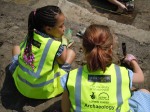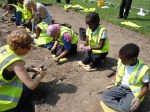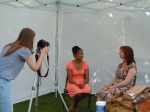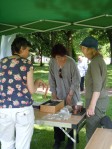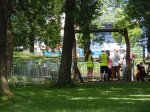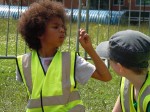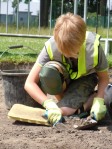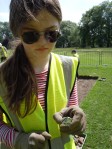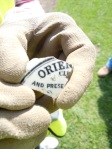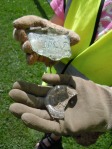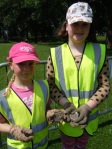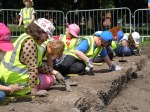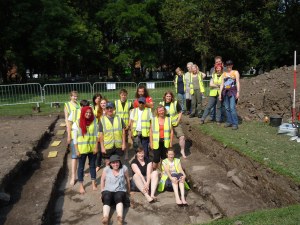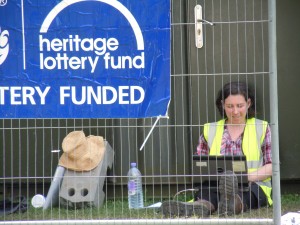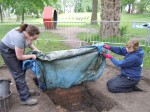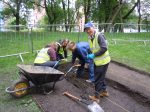Schools in the Park
Today we welcomed 60 pupils and their teachers from Medlock Primary School to the site, for a ‘hands-on’ archaeology workshop. We began by exploring maps from different periods in the Park’s past, noticing what had changed through the course of the 19th and 20th centuries. We also looked at copies of the old postcards from the Park, and the Medlock children analysed differences in the dress, appearance and behaviour of children 100 years ago. They also made thoughtful comments about the statue that used to be in the Park, and thought about the ways in which the trees had grown and the lake had disappeared. We explored some of the best finds from the site, and they correctly guessed the use of our small glass bottles, which were used for medicines!
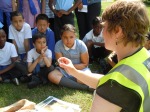
The classes then moved between excavating on site, washing finds and participating in a drama workshop under the trees. Star finds from their hard work on site include worked stone, tile and window glass from the pavilion; fragments of old ‘cod’ bottles (early fizzy pop!); a beautiful white and blue marble, and a thin stick of slate ‘pencil’ used for writing on school slates. We also found sherds of bottle glass and fine white china. Some of the most interesting discoveries however, were lumps of iron and glass slag: probably brought in from factory sites nearby to ‘make up’ the boggy surface of the land before the pavilion was built (see summary of the Excavations for 2011). This tells us not just about activities in the Park but wider industry in the city of Manchester. Well done Medlock!
Coal on Cotton
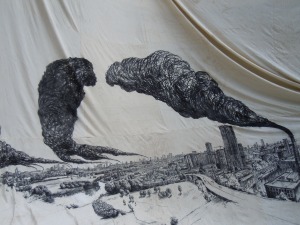
The discoveries made by the children created a strong resonance with the extraordinary final work by Nikhil Chopra, following his 72 hour ‘dawn ‘till dusk’ performance at the Whitworth Art Gallery. As the children teased out shining clumps of coal and slick flecks of charcoal from the silts and clays on site, we were reminded of the fuel of the industrial revolution. Chopra’s final cityscape, hung outside the gallery, formed a background for the start of our workshop, as we talked about how archaeologists are able to investigate the Industrial Revolution, through the architecture and material culture of different classes in Manchester’s past. Chopra’s tent, clothing and small bundles of necessities, put us in mind of the homeless who still seek shelter in the park, and prompted us to think anew about the long-term legacy of these global historical transformations, for Manchester’s contemporary citizens. It has been an inspiring few days.
Site Art
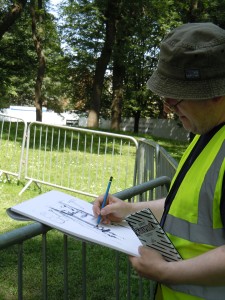 On site meanwhile, we have our own artist at work. Trained in Fine Art, Frank Collins is one of our Community Volunteers, as well as a regular volunteer at the Whitworth Art Gallery. He has been sketching the dig as it unfolds, with some stunning results, which somehow capture the relationship between the archaeologist, their tools and the work, in a much more intimate way than a photograph or video. We will be featuring his work here as it develops over the next few days.
On site meanwhile, we have our own artist at work. Trained in Fine Art, Frank Collins is one of our Community Volunteers, as well as a regular volunteer at the Whitworth Art Gallery. He has been sketching the dig as it unfolds, with some stunning results, which somehow capture the relationship between the archaeologist, their tools and the work, in a much more intimate way than a photograph or video. We will be featuring his work here as it develops over the next few days.

